What to Do in Paris: Félix Vallotton at the Grand Palais
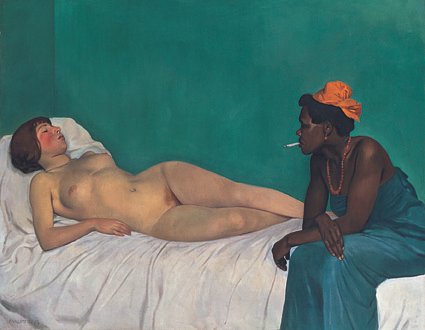
Thu 28 Nov 2013
If you’re wondering what to do in Paris, the city is flush with exhibitions between now and the end of the year, among which Félix Vallotton: Le feu sous la glace, at the Grand Palais, should not be missed.
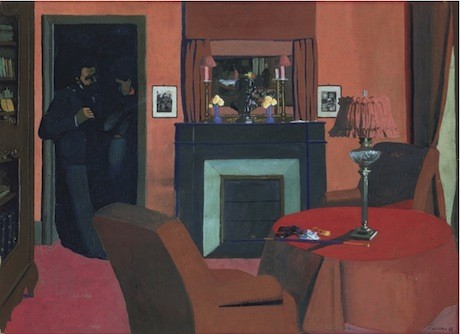
La Chambre rouge, 1898, tempera sur carton, 50 x 68.5 cm. Lausanne,
Musée cantonal des Beaux-Arts, acquisition 1983. © Musée cantonal
des Beaux-Arts de Lausanne/Photo J.-C. Ducret.
Vallotton (1865–1925) was a Franco-Swiss painter who was part of the Nabis group of avant-garde painters at the turn of the 20th century. Vallotton is, however, less well known than his contemporaries, such as Bonnard and Vuillard.
I was surprised to discover how prolific Vallotton was—his works include some 1,700 paintings and 200 prints—dispersed throughout museums and private collections in the Netherlands, France, Switzerland and even Japan. He even dabbled in some writing and theater. There seems little that Vallotton did not dip into, from still life, portraits and nudes to landscapes and woodcuts. What I appreciated about the exhibition is how it was not curated in the usual chronological manner but took a thematic approach.
It’s hard to put a finger on Vallotton’s landscapes—there is a lack of realism in the style of the impressionists, yet there is a discordant tone and strange perspective, or lack of. Vallotton often painted his landscapes from memory, and deliberately ignored the rules of perspective to flatten his landscapes instead of giving them depth. There is also a certain dreamy quality to some of his landscapes, as he mixed reality and memory or imagination, sometimes even combining impossible perspectives and lightings from different times of the day into one painting.
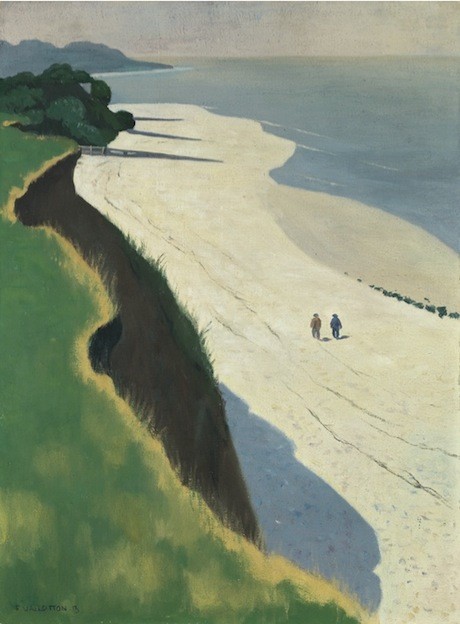
La Grève blanche, Vasouy, 1913, huile sur toile, 73 x 54 cm.
Suisse, collection particulière.© Collection particulière/photo
Markus Mühlheim, Polith SA, Suisse.
Another enjoyable part of the exhibition is Vallotton’s many street scenes depicting Parisian society, be it women fingering wares at le Bon Marché; a sudden deluge and the opening of a hundred umbrellas; or demonstrations, mobs and street violence in his more politically charged prints.
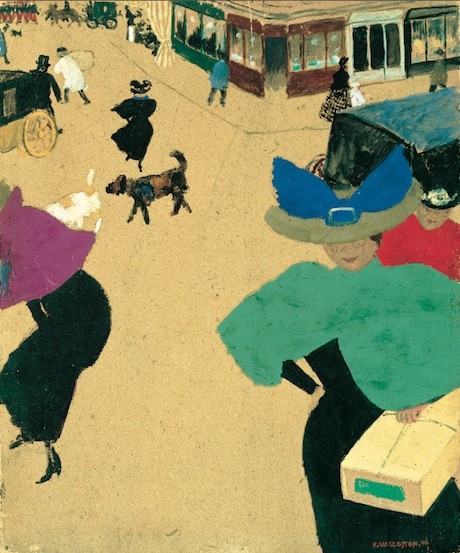
Scène de rue à Paris, vers 1895–1897, gouache et huile sur carton,
35.9 x 29.5 cm. New York, The Metropolitan Museum of Art, Robert
Lehman Collection. © The Metropolitan Museum of Art, Dist. Rmn-Grand
Palais/image of the MMA.
Feu sous la glace or Fire beneath the Ice is the title of the exhibition, alluding to Vallotton’s glacial and clear-eyed view of society. The artist’s ironic mockery of bourgeois mores is quite delicious, none more so than in his series of woodcuts depicting the goings-on taking place behind closed doors, culminating in his famous L’Assassinat. These scenes of adultery wouldn’t be out of place in a newspaper column of faits divers. Seduction, connivance, deception—we share the painter’s cold observation of couples in flagrante delicto, the lush interiors and many doors and thresholds of the paintings like so many webs of deceit spun.
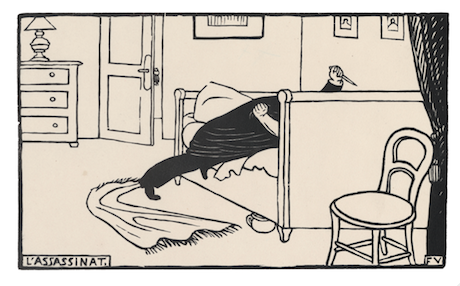 L’Assassinat, 1893, xylographie, 14.7 x 24.5 cm (planche). Paris,
L’Assassinat, 1893, xylographie, 14.7 x 24.5 cm (planche). Paris,
Bibliothèque nationale de France, département des Estampes et
de la Photographie. © BnF, Dist. Rmn-Grand Palais/image BnF.
Yet there is much astir beneath the supposed detachment of the artist. Vallotton wrote in his diary, “I think I paint for people who are level-headed but who have an unspoken vice deep inside them. I actually like this state, which is one I share.” Although the object of scorn in some of his paintings, women undoubtedly had a hold on the artist. He painted them in the intimacy of their rooms, in baths, reposing or in domestic contexts.
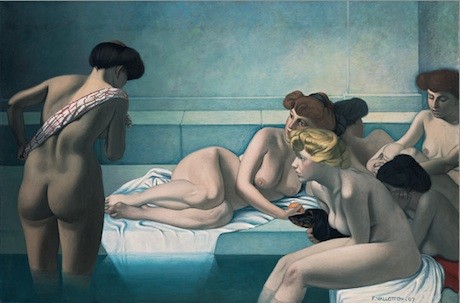
Le Bain turc, 1907, huile sur toile, 130.5 x 195.5 cm. Genève, Musées d’Art
et d’Histoire de la Ville de Genève. © Musées d’Art et d’Histoire de la Ville de
Genève/photo Bettina Jacot-Descombes.
There is also an interesting section of paintings of women in “duets”—ambiguous, enigmatic portrayals of two women often of different ages and social classes, whose relationship we are left to ponder. One of his most renowned paintings is La Blanche et La Noire. The (presumed) servant sits on the bed smoking a cigarette and gazing at her mistress, who may or may not be sleeping (her body is held in an awkward pose, she seems almost to be offering her body, or holding her breath) with such nonchalance, it’s no wonder it shocked in Vallotton’s time.
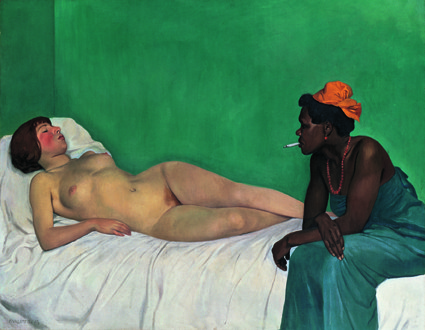
La Blanche et la Noire, 1913, huile sur toile, 114 x 147 cm. Winterthour,
Fondation Hahnloser/Jäggli, Villa Flora. © Fondation Hahnloser/Jaeggli,
Winterthour.
Le feu sous la glace is on view through January 20, 2014, at the Grand Palais (3, avenue du Général Eisenhower, in the 8th Arrondissement).
Related Link
Grand Palais